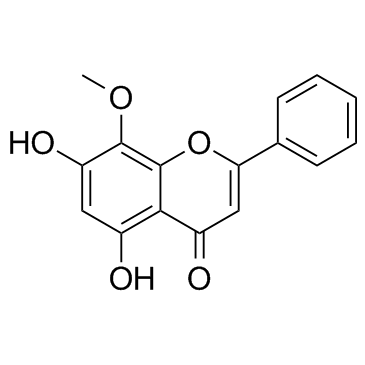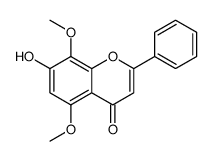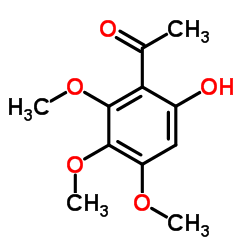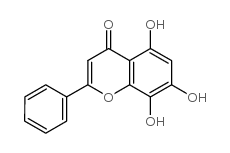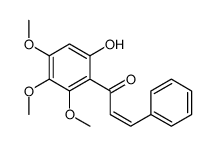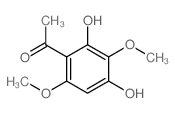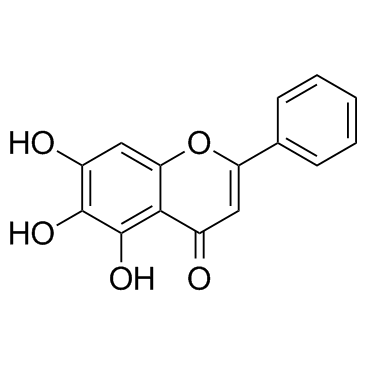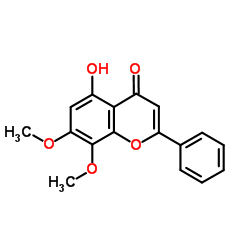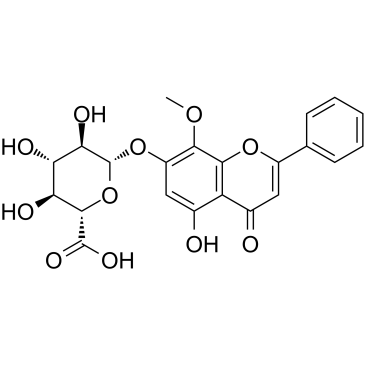632-85-9
| Name | wogonin |
|---|---|
| Synonyms |
Norwogonin 8-methyl ether
5,7-DIHYDROXY-8-METHOXYFLAVON 5,7-Dihydroxy-8-methoxy-2-phenyl-chromen-4-on Wogonin 5,7-Dihydroxy-8-methoxy-2-phenyl-4H-chromen-4-one 5,7-dihydroxy-8-methoxy-2-phenyl-chromen-4-one 4H-1-Benzopyran-4-one, 5,7-dihydroxy-8-methoxy-2-phenyl- MFCD00017736 5,7-dihydroxy-8-methoxyflavone vogonin WOOGONIN WILDYAMP.E |
| Description | Wogonin is a naturally occurring mono-flavonoid, can inhibit the activity of CDK8 and Wnt, and exhibits anti-inflammatory and anti-tumor effects. |
|---|---|
| Related Catalog | |
| Target |
CDK8 Wnt |
| In Vitro | Wogonin (0-200 μM) exhibits a dose- and time- dependent reduces in cell viability of caco-2, SW1116 and HCT116 cells. Wogonin (10-40 μM) induces G1 phase arrest in HCT-116 cells. Wogonin also supresses Wnt signaling pathway in HCT116 cells. Wogonin interfers in the activity of transcription factor TCF/Lef family. Moreover, Wogonin inhibits β-catenin-mediated transcription through suppressing the activity of CDK8[1]. Wogonin shows cytotoxic and antiproliferative effects on HeLa cells. Wogonin (90 µM) induces cell cycle arrest at G0-G1 phase, and suppresses the levels of cyclin D1 and Cdk4 markedly in HeLa cells[2]. Wogonin (1.25, 2.5, 5, 10, 20 μg/ml) suppresses EtOH-induced inflammatory response in RAW264.7 cells[3]. |
| In Vivo | Wogonin (30, 60 mg/kg) reduces tumor growth of HCT116 cells in a xenograft model[1]. Wogonin (25, 50, 100 mg/kg) protects against liver injury and pathological characteristics of ALD in mice. Wogonin activates PPAR-γ expression in mice with ALD and EtOH induced RAW264.7 cells[3]. |
| Cell Assay | HCT116 cells are planted on a 96-well plate (1 × 105 cells per well). Different concentrations of wogonin are added and incubated for 24 h. Subsequently, 20 μL of MTT solution (5 mg/mL) is transferred to each well and the plates are incubated for 4 h at 37°C and 5% CO2. The supernatant is aspirated off and 100 μL DMSO is added to dissolve the formazan crystal. The mixture is shaken and measured at 570 nm using a universal microplate reader. |
| Animal Admin | C57BL/6 mice, male, 6-8 weeks old, weighing 18-22 g mice are housed at comfortable environment and are acclimatized for 3 days before the experiment. A total of 48 mice are randomLy divided into six groups of 8 animals, respectively control diet (CD)-fed mice, EtOH-fed mice, wogonin-treated mice at the dose of 25, 50, 100 mg/kg/day and the positive (dexamethasone, 1 mg/kg/day)-treated mice. Modeling process has a total of 16 days including a liquid diet adaptation period for 3 days and modeling for 13 days. The EtOH-fed mice are fed containing 5% v/v ethanol liquid diets adding certain vitamin and choline for 16 days, and mice are gavaged with a single binge ethanol administration (5 g/kg, body weight, 20% ethanol) at last day. At the same time, the wogonin-treated mice and the positive-treated mice are not only plus the ethanol administration, but also plus the medicines by gavage daily, whereas the CD-fed mice are fed with control liquid diets and gavaged with isocaloric maltose-dextrin at last day. All diets are prepared fresh daily. 9 h after the last gavage alcohol, mice are sacrificed under anaesthesia, the liver tissues and blood are collected for further analysis. |
| References |
| Density | 1.4±0.1 g/cm3 |
|---|---|
| Boiling Point | 518.8±50.0 °C at 760 mmHg |
| Melting Point | 203-206°C |
| Molecular Formula | C16H12O5 |
| Molecular Weight | 284.263 |
| Flash Point | 198.4±23.6 °C |
| Exact Mass | 284.068481 |
| PSA | 79.90000 |
| LogP | 2.14 |
| Vapour Pressure | 0.0±1.4 mmHg at 25°C |
| Index of Refraction | 1.669 |
| Storage condition | 2-8°C |
|
SECTION 1: Identification of the substance/mixture and of the company/undertaking Product identifiers Product name: Wogonin hydrate REACH No.: A registration number is not available for this substance as the substance or its uses are exempted from registration, the annual tonnage does not require a registration or the registration is envisaged for a later registration deadline.
CAS-No.: 632-85-9 Relevant identified uses of the substance or mixture and uses advised against Identified uses: Laboratory chemicals, Manufacture of substances SECTION 2: Hazards identification Classification of the substance or mixture Not a hazardous substance or mixture according to Regulation (EC) No. 1272/2008. This substance is not classified as dangerous according to Directive 67/548/EEC. Label elements The product does not need to be labelled in accordance with EC directives or respective national laws. Other hazards - none SECTION 3: Composition/information on ingredients Substances Synonyms: 5,7-Dihydroxy-8-methoxyflavone Formula: C16H12O5 · xH2O Molecular Weight: 284,26 g/mol CAS-No.: 632-85-9 No components need to be disclosed according to the applicable regulations. SECTION 4: First aid measures Description of first aid measures If inhaled If breathed in, move person into fresh air. If not breathing, give artificial respiration. In case of skin contact Wash off with soap and plenty of water. In case of eye contact Flush eyes with water as a precaution. If swallowed Never give anything by mouth to an unconscious person. Rinse mouth with water. Most important symptoms and effects, both acute and delayed The most important known symptoms and effects are described in the labelling (see section 2.2) and/or in section 11 Indication of any immediate medical attention and special treatment needed no data available SECTION 5: Firefighting measures Extinguishing media Suitable extinguishing media Use water spray, alcohol-resistant foam, dry chemical or carbon dioxide. Special hazards arising from the substance or mixture Carbon oxides Advice for firefighters Wear self contained breathing apparatus for fire fighting if necessary. Further information no data available SECTION 6: Accidental release measures Personal precautions, protective equipment and emergency procedures Avoid dust formation. Avoid breathing vapours, mist or gas. For personal protection see section 8. Environmental precautions Do not let product enter drains. Methods and materials for containment and cleaning up Sweep up and shovel. Keep in suitable, closed containers for disposal. Reference to other sections For disposal see section 13. SECTION 7: Handling and storage Precautions for safe handling Provide appropriate exhaust ventilation at places where dust is formed.Normal measures for preventive fire protection. For precautions see section 2.2. Conditions for safe storage, including any incompatibilities Store in cool place. Keep container tightly closed in a dry and well-ventilated place. Recommended storage temperature: 2 - 8 °C Specific end use(s) A part from the uses mentioned in section 1.2 no other specific uses are stipulated SECTION 8: Exposure controls/personal protection Control parameters Components with workplace control parameters Exposure controls Appropriate engineering controls General industrial hygiene practice. Personal protective equipment Eye/face protection Use equipment for eye protection tested and approved under appropriate government standards such as NIOSH (US) or EN 166(EU). Skin protection Handle with gloves. Gloves must be inspected prior to use. Use proper glove removal technique (without touching glove's outer surface) to avoid skin contact with this product. Dispose of contaminated gloves after use in accordance with applicable laws and good laboratory practices. Wash and dry hands. The selected protective gloves have to satisfy the specifications of EU Directive 89/686/EEC and the standard EN 374 derived from it. Body Protection Choose body protection in relation to its type, to the concentration and amount of dangerous substances, and to the specific work-place., The type of protective equipment must be selected according to the concentration and amount of the dangerous substance at the specific workplace. Respiratory protection Respiratory protection is not required. Where protection from nuisance levels of dusts are desired, use type N95 (US) or type P1 (EN 143) dust masks. Use respirators and components tested and approved under appropriate government standards such as NIOSH (US) or CEN (EU). Control of environmental exposure Do not let product enter drains. SECTION 9: Physical and chemical properties Information on basic physical and chemical properties a) AppearanceForm: solid b) Odourno data available c) Odour Thresholdno data available d) pHno data available e) Melting point/freezingno data available point f) Initial boiling point and no data available boiling range g) Flash pointno data available h) Evapouration rateno data available i) Flammability (solid, gas) no data available j) Upper/lowerno data available flammability or explosive limits k) Vapour pressureno data available l) Vapour densityno data available m) Relative densityno data available n) Water solubilityno data available o) Partition coefficient: n- no data available octanol/water p) Auto-ignitionno data available temperature q) Decompositionno data available temperature r) Viscosityno data available s) Explosive propertiesno data available t) Oxidizing propertiesno data available Other safety information no data available SECTION 10: Stability and reactivity Reactivity no data available Chemical stability Stable under recommended storage conditions. Possibility of hazardous reactions no data available Conditions to avoid no data available Incompatible materials Strong oxidizing agents Hazardous decomposition products Other decomposition products - no data available In the event of fire: see section 5 SECTION 11: Toxicological information Information on toxicological effects Acute toxicity no data available Skin corrosion/irritation no data available Serious eye damage/eye irritation no data available Respiratory or skin sensitisation no data available Germ cell mutagenicity no data available Carcinogenicity IARC:No component of this product present at levels greater than or equal to 0.1% is identified as probable, possible or confirmed human carcinogen by IARC. Reproductive toxicity no data available Specific target organ toxicity - single exposure no data available Specific target organ toxicity - repeated exposure no data available Aspiration hazard no data available Additional Information RTECS: LK8331000 To the best of our knowledge, the chemical, physical, and toxicological properties have not been thoroughly investigated. SECTION 12: Ecological information Toxicity no data available Persistence and degradability no data available Bioaccumulative potential no data available Mobility in soil no data available Results of PBT and vPvB assessment PBT/vPvB assessment not available as chemical safety assessment not required/not conducted Other adverse effects no data available SECTION 13: Disposal considerations Waste treatment methods Product Offer surplus and non-recyclable solutions to a licensed disposal company. Contaminated packaging Dispose of as unused product. SECTION 14: Transport information UN number ADR/RID: -IMDG: -IATA: - UN proper shipping name ADR/RID: Not dangerous goods IMDG: Not dangerous goods IATA:Not dangerous goods Transport hazard class(es) ADR/RID: -IMDG: -IATA: - Packaging group ADR/RID: -IMDG: -IATA: - Environmental hazards ADR/RID: noIMDG Marine pollutant: noIATA: no Special precautions for user no data available SECTION 15: Regulatory information This safety datasheet complies with the requirements of Regulation (EC) No. 1907/2006. Safety, health and environmental regulations/legislation specific for the substance or mixture no data available Chemical Safety Assessment For this product a chemical safety assessment was not carried out SECTION 16: Other information Further information Copyright 2013 Co. LLC. License granted to make unlimited paper copies for internal use only. The above information is believed to be correct but does not purport to be all inclusive and shall be used only as a guide. The information in this document is based on the present state of our knowledge and is applicable to the product with regard to appropriate safety precautions. It does not represent any guarantee of the properties of the product. Corporation and its Affiliates shall not be held liable for any damage resulting from handling or from contact with the above product. See and/or the reverse side of invoice or packing slip for additional terms and conditions of sale. |
CHEMICAL IDENTIFICATION
HEALTH HAZARD DATAACUTE TOXICITY DATAMUTATION DATA
|
| Hazard Codes | Xn |
|---|---|
| Risk Phrases | R20/21/22:Harmful by inhalation, in contact with skin and if swallowed . R36/37/38:Irritating to eyes, respiratory system and skin . |
| Safety Phrases | S26-S36/37/39-S45 |
| RIDADR | 3145 |
| RTECS | SJ8922500 |
| Packaging Group | III |
| Hazard Class | 8 |
| Precursor 10 | |
|---|---|
| DownStream 6 | |


